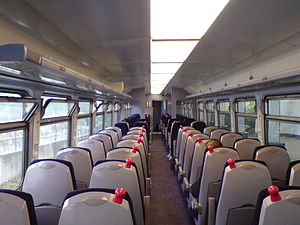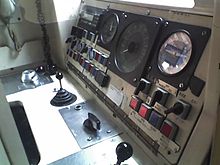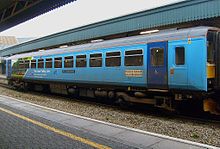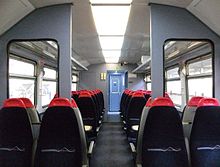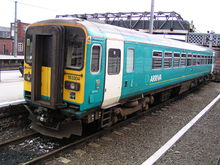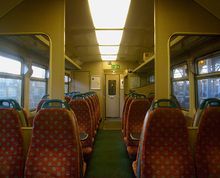- British Rail Class 153
-
British Rail Class 153 Super Sprinter 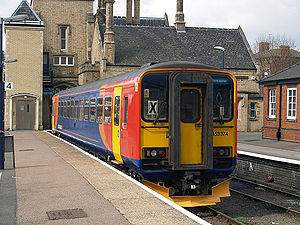
East Midlands Trains 153374 at Lincoln.
The refurbished interior of a First Great Western Class 153.In service 1991/2 - present Manufacturer British Leyland
Converted to Cl153 by Hunslet-BarclayFamily name Sprinter Constructed 1987 - 1988
Converted 1991 - 1992Refurbishment Various Number built 70 (as 35 Class 155s prior to conversion) Formation Single car Capacity 72 or 75 Operator Arriva Trains Wales
East Midlands Trains
First Great Western
London Midland
National Express East Anglia
Northern RailSpecifications Car body construction Steel underframe. Aluminium alloy body and roof. Car length 23.2 m (76 ft 1 in) Width 2.7 m (8 ft 10 in) Maximum speed 75 mph (120 km/h) Weight 41.2 t (40.5 long tons; 45.4 short tons) Engine(s) One Cummins NT855R5
285hp DieselTransmission Voith Hydraulic T211r
2 axles drivenSafety system(s) AWS, TPWS Coupling system BSI[1] Gauge 1,435 mm (4 ft 8.5 in) The British Rail Class 153 Super Sprinter is a single car diesel multiple unit converted from British Rail Class 155s.
Contents
Description
These units were originally built as two-car Class 155 units by British Leyland from 1987–88, but were converted by Hunslet-Barclay at Kilmarnock from 1991-92. The layout of the original non-cab ends was different from the original cab end, so the ends are noticeably distinct, and the vehicles are not symmetrical.
Their maximum speed is 75 mph (121 km/h) and suited for working less popular local services such as the London Midland service from Coventry to Nuneaton and the Heart of Wales Line. They are fitted with standard BSI auto-couplers and are therefore able to work in tandem with other multiple units fitted with the same coupler, including Class 150, Class 156 and Class 158 units as well as newer units like the Class 170 DMU.
The new or small cab is significantly smaller than the original Leyland cab and encroaches on the door vestibule area, providing cramped conditions for Drivers and Guards. Similar to other Sprinter Units, such as the classes 150/2, 156 and 158, these units have gangway door connections at either end that allow passengers and staff to walk between units working in multiple. These units also have the benefit of having passenger door control panels at either end of the cars.
Units are numbered in the range 153301-335 and 153351-385. Individual cars are numbered 52301-335 and 57351-385 (originally 57301-335).
Operations
British Rail
British Rail needed replacements for its fleet of Class 121 and 122 diesel railcars for use on branch lines and other lightly used services
Post Privatisation
Upon privatisation of British Rail, the Class 153 fleet was divided amongst several different operators.
Wales
Arriva Trains Wales has a fleet of 8 Class 153s. They are normally used on rural branchlines, such as the Heart of Wales Line from Shrewsbury to Swansea and the line from Wrexham Central to Bidston - but are also used on some mainline services. In December 2005, Arriva employed a Class 153 to "shuttle" along the Butetown Branch Line between Cardiff Queen Street and Cardiff Bay stations, however, this was later replaced by a Class 121 Bubblecar.
Following the timetable change on 9 December 2007, Arriva Trains Wales lost three Class 153 units. Two were transferred to East Midlands Trains with the other going to First Great Western.
Midlands
London Midland use ten Class 153 DMUs on commuter lines in the West Midlands including Coventry to Nuneaton and the Marston Vale Line between Bedford and Bletchley.
All ten units were inherited from Central Trains in their livery. All of the units are being repainted into London Midland city lines livery upon refurbishment at Eastleigh works. The Class 153s that were used on the Stourbridge Town Branch Line have recently been replaced by new built lightweight Class 139 railcars. This was due to take place in December 2008, but the delivery of the new units was delayed, and after several months of bustitution London Midland reintroduced diesel services from 15 March pending the completion of Class 139 testing. The class 139 received passenger certification from Network Rail in March 2009[2] and the service finally began three months later.[3]
East Midlands Trains fleet of Class 153s are used on rural routes in the East Midlands. These are:
- Nottingham to Worksop (There is one diagram which uses two units)
- Nottingham to Matlock via Derby
- Nottingham to Skegness (Only coupled onto other units or if the Class 156 or Class 158 fails then the Class 153 replacement)
- Leicester to Lincoln Central
- Peterborough to Lincoln Central and Doncaster
- Newark Northgate to Cleethorpes
- Derby to Crewe via Stoke on Trent
East Midlands Trains inherited many different examples of Class 153 units, receiving six from Central Trains, three from National Express East Anglia and four from storage at Eastleigh depot (formerly in service with First Great Western). On 9 December 2007, East Midlands Trains has also received two additional Class 153 units from Arriva Trains Wales and two additional trains from Northern.
All of the East Midlands Trains Class 153 units have been repainted into the local lines livery of the company with the exception of three. The three units numbered 153376, 153379 and 153384 still wear the Central trains colours, albeit with East Midlands Trains branding.
As of July 2010 the first unit from the local fleet for East Midlands Trains 153319 entered Neville Hill depot in Leeds for a C6 refresh programme. This work will include corrosion repair, internal refresh and a cab refurbishment programme.[4]
South West England
Wessex Trains refurbished Class 153 No. 153369 at Bristol Temple Meads.
First Great Western took over the Wessex Trains fleet upon the merger of the two franchises. Wessex Trains had, in turn, inherited its fleet of 13 units from its predecessor, Wales and West.
Units are used on local services in Cornwall, Devon, and around Bristol. They are also used on Bristol Temple Meads to Weymouth, Southampton, and Worcester services and Swindon via Melksham to Southampton service.
In mid-2004, Wessex Trains received a further two units from Central Trains (unit nos. 153329 and 153369) to allow it to lengthen some services.
Following the introduction of a new timetable on 12 December 2006, four units were taken off lease and stored at the former Alsthom works at Eastleigh. They were Nos. 153302, 153308, 153355 and 153374. This decision was criticised at the time by passengers, this was due to an increase in overcrowding on services in the West Country. After a period in storage these four units were pressed into service with East Midlands Trains.
On 9 December 2007, First Great Western received an additional Class 153 (number 153361) from Arriva Trains Wales bringing its total to 12. This unit arrived in the blue with gold star livery of former operator First North Western (still carried by the FGW Class 142s).
From late 2007, a refurbishment programme commenced to refurbish the 153 fleet. The trains have been externally reliveried in the 'Local Lines' livery (an adaptation of the 'Dynamic Lines' livery consisting of names of local places and attractions forming the lines) and the interiors have received the following improvements:
- Installation of new carpet
- Repainted dado side panels and wall ends
- Refurbished toilet area with new flooring, wall coverings, toilet and sink basin
- Installation of Richmond 'Navigator' high backed seats in the navy blue 'First Great Western' moquette. The earlier Wessex refurbished Class 153s No. 153329, 153369, and the ex-Arriva Trains Wales 153361 feature Chapman seating as per the FGW Class 150s.
- Installation of brighter interior saloon lighting diffusers
This refurbishment programme was completed by early June 2008.
Due to fire damage on car No.52221 of Class 150/2 unit 150221, 153369 was temporarily joined up with surviving car 57221, and the formation renumbered 153399. This hybrid has now been disbanded as car No. 52221 has been repaired.
For Summer 2011, two LM Class 153s, 153325 & 153333, have been allocated to the South West for strengthening purposes, based at Exeter (EZ) depot for the duration.
Northern England
The Northern Rail franchise started operations in December 2004. They inherited the fleets previously operated by Arriva Trains Northern and First North Western, whose routes the new franchise incorporated.
Northern inherited a fleet of eight units from First North Western (FNW), which are used on local services around Manchester, Chester and on Lancaster to Barrow-in-Furness to Carlisle and Preston to Ormskirk services. The fleet was repainted in the now obsolete North Western Trains blue and gold livery. Prior to becoming part of Northern, four former FNW units were transferred to the Arriva Trains Wales franchise, since the lines operated by FNW in Wales were transferred to this new company.
A larger fleet of 12 units were inherited from Arriva Trains Northern (ATN). They are used on various local services around Leeds, Doncaster, and Sheffield.
In December 2007, two units were taken off lease from Northern and transferred to East Midlands Trains. Both units, 153319 and 153357 carried Arriva livery.
From late 2007, a re-livery programme has started on Northern's Class 153 trains. All of Northern's Class 153 trains have been repainted into Northern livery. A Class 153 usually works with a Class 158 to make 3-car formations on Leeds-Settle-Carlisle services.
East Anglia
Anglia Railways inherited a small fleet of seven units, for local services in Suffolk and Norfolk. Services operated by these units included Ipswich to Cambridge, Peterborough, Felixstowe and Lowestoft, and Norwich to Lowestoft, Great Yarmouth and Cromer. One set was also hired to First Great Eastern for use on the Sudbury branch.
Anglia Railways named its Class 153 fleet after famous local figures:
- 153306 - Edith Cavell
- 153309 - Gerard Fiennes
- 153311 - John Constable
- 153314 - Delia Smith
- 153322 - Benjamin Britten
- 153326 - Ted Ellis
- 153335 - Michael Palin
In 2003, Anglia started to refurbish its fleet, and repaint them in Anglia Railways livery. However, only three (unit nos. 153309/322/335) were completed; In 2004, Anglia became part of the 'One' franchise operated by the National Express Group (which was subsequently renamed National Express East Anglia). inheriting the fleet of seven units, for local services in Suffolk and Norfolk. Services operated by these units included Norwich to Sheringham and Great Yarmouth, Norwich to Lowestoft, they were also sometimes seen on the Ipswich to Ely Line.
Liveries
-
First Great Western livery--Maritime Line from Truro to Falmouth
Fleet
Class Operator No. Built Year Built Cars per Set Unit nos. Notes Class 153 Arriva Trains Wales 70 1991-1992 1 153303, 153312, 153320, 153323, 153327, 153353, 153362, 153367 East Midlands Trains 153302, 153308, 153310-153311, 153313, 153319, 153321, 153326, 153355, 153357, 153374, 153376, 153379, 153381, 153383-153385 London Midland 153325, 153333-153334, 153354, 153356, 153364-153365, 153371, 153375 National Express East Anglia 153306, 153309, 153314, 153322, 153335 Northern Rail 153301, 153304, 153307, 153315-153317, 153324, 153328, 153330-153332, 153351-153352, 153358-153360, 153363, 153366, 153378 First Great Western 153305, 153318, 153329, 153361, 153368, 153369, 153370, 153372-153373, 153377, 153380, 153382 Railway models
When the units were first introduced, Hurst models produced a detailing kit to convert a Dapol model of a 155 into a 153.[5]
The Class 153 has been produced in OO scale by Hornby. The following liveries are/were available; Central Trains, First Northern Star, Northern Rail, Regional Railways, East Midlands Trains, London Midland City and Great Scenic Railways of Wessex and Cornwall (Wessex Trains). These models have been praised for their detail.[6]
More recently, Dapol have announced a N Scale version.[7]
Making Tracks have a digital model available for the PC Railway simulator Microsoft Train Simulator.[8]
Just Trains have recently released a digital model for the PC railway simulator Railworks
References
- ^ "Mechanical And Electrical Coupling Index". Rail Safety and Standards Board. http://www.rssb.co.uk/RGS/Pages/MECHANICALANDELECTRICALCOUPLINGINDEX.aspx. Retrieved 2010-12-20.
- ^ "Stourbridge railcar receives its passenger licence". London Midland. 2 April 2009. http://www.londonmidland.com/news/latest-news/stourbridge-railcar-receives-its-passenger-licence/. Retrieved 11 April 2009.
- ^ "Latest News". Parry People Movers. 2009-06-19. http://www.parrypeoplemovers.com/latest_news.htm. Retrieved 2009-06-24.
- ^ "The News in Pictures". Railway Herald (241): p. 2. 2010-10-04. http://www.railwayherald.com/magazine/pdf/RHUK/Issue241HIGH.pdf. Retrieved 2010-12-21.
- ^ "DKU103 Pair of Class 153 Conversion Kits". Hurst Models. http://www.hurstmodels.com/4/4mm_units.htm.
- ^ "Error 404". http://www.intertrains.com/page.php?pageid=92.
- ^ "Class 153 released". Dapol. http://www.dapol.co.uk/index.php?option=com_content&task=view&id=514&Itemid=65.
- ^ "BMUC 6 :: Leyland Class 153 / Class 155 Stock Pack". Making Tracks. http://www.makingtracks-online.co.uk/index.php?option=com_content&view=article&id=72&Itemid=100.
External links
20 m: 23 m (Super Sprinter): unbuilt: Diesel multiple units of the United Kingdom First generation units: First Generation
Original TOPS:First generation units
(pre-TOPS):British United Traction · Derby Lightweight · Metro-Cammell · Railbus · GWR Railcars · LMS Railcars
Second generation units: Diesel-electric units: Southern Railway designations: Families Categories:- British Rail diesel multiple units
- Leyland vehicles
Wikimedia Foundation. 2010.

